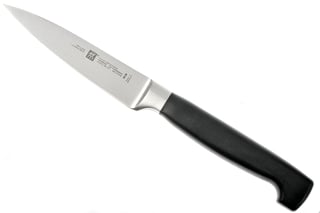Most kitchen knives have pointed tips. I can imagine trying to improve safety (e.g. if they're accidentally dropped) by rounding the tip. For example, a paring knife might look like the one on the right instead of the one on the left:
But I wonder what is lost on the culinary side? I cannot think of a recipe where the tip is essential. Usually when I need a pointy thing a fork works better than the tip of a knife. Certainly there are knives with less pronounced tips such as the Santoku stye knife and carving knife.
The first has a less pronounced tip but could still cut through your shoe. The second had a rounded tip but is a more specialized kind of knife.
Imagine you don't have any knives with pointed tips. What tasks become more of a hassle to accomplish?




